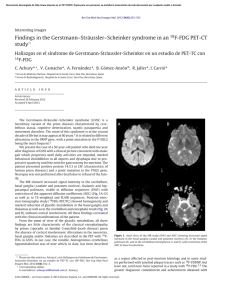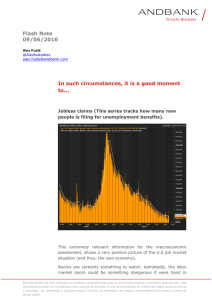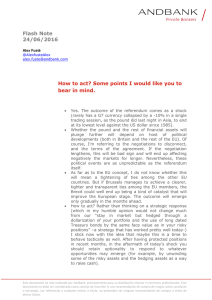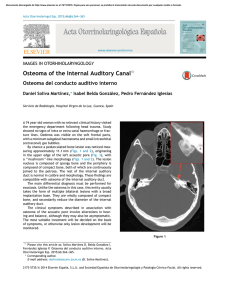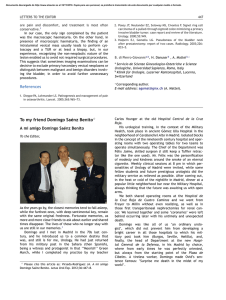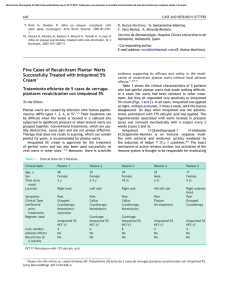CASE FOR DIAGNOSIS Submammary Perifollicular
Anuncio
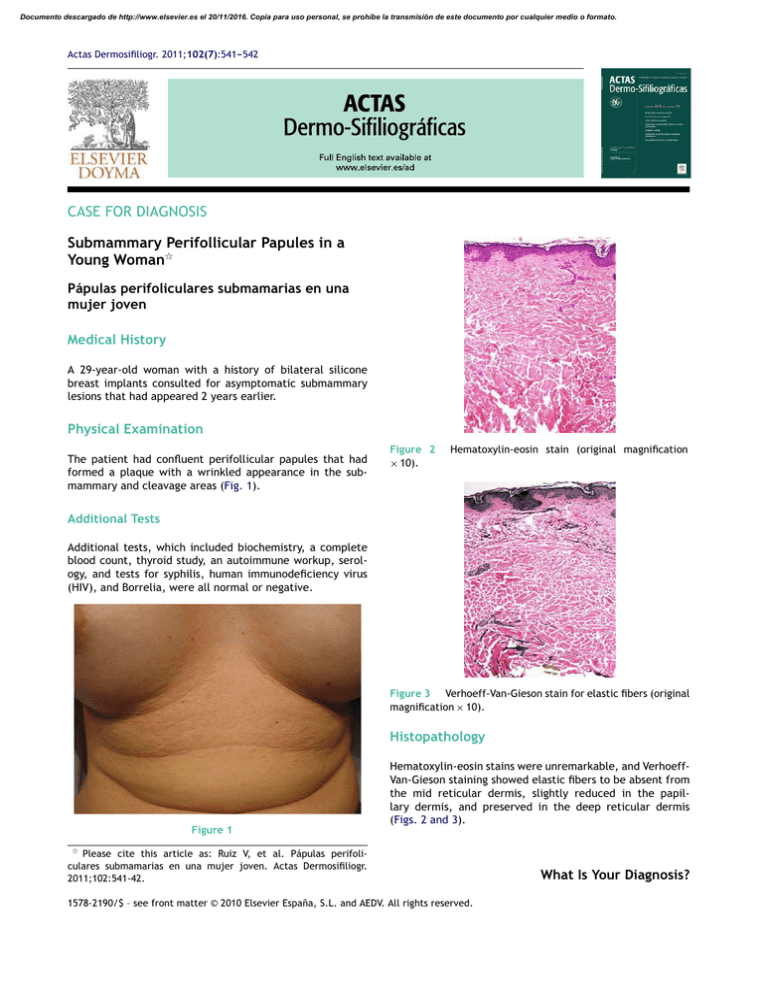
Documento descargado de http://www.elsevier.es el 20/11/2016. Copia para uso personal, se prohíbe la transmisión de este documento por cualquier medio o formato. Actas Dermosifiliogr. 2011;102(7):541---542 CASE FOR DIAGNOSIS Submammary Perifollicular Papules in a Young Woman夽 Pápulas perifoliculares submamarias en una mujer joven Medical History A 29-year-old woman with a history of bilateral silicone breast implants consulted for asymptomatic submammary lesions that had appeared 2 years earlier. Physical Examination The patient had confluent perifollicular papules that had formed a plaque with a wrinkled appearance in the submammary and cleavage areas (Fig. 1). Figure 2 × 10). Hematoxylin-eosin stain (original magnification Additional Tests Additional tests, which included biochemistry, a complete blood count, thyroid study, an autoimmune workup, serology, and tests for syphilis, human immunodeficiency virus (HIV), and Borrelia, were all normal or negative. Figure 3 Verhoeff-Van-Gieson stain for elastic fibers (original magnification × 10). Histopathology Hematoxylin-eosin stains were unremarkable, and VerhoeffVan-Gieson staining showed elastic fibers to be absent from the mid reticular dermis, slightly reduced in the papillary dermis, and preserved in the deep reticular dermis (Figs. 2 and 3). Figure 1 夽 Please cite this article as: Ruiz V, et al. Pápulas perifoliculares submamarias en una mujer joven. Actas Dermosifiliogr. 2011;102:541-42. 1578-2190/$ – see front matter © 2010 Elsevier España, S.L. and AEDV. All rights reserved. What Is Your Diagnosis? Documento descargado de http://www.elsevier.es el 20/11/2016. Copia para uso personal, se prohíbe la transmisión de este documento por cualquier medio o formato. 542 Diagnosis Mid dermal elastolysis. Discussion Mid dermal elastolysis was first described by Shelly and Wood in 1977. It is a rare condition, with only about 80 cases reported in the literature. It preferentially affects women aged between 30 and 40 years.1 It has 2 clinically distinct variants, which on occasions can occur in the same patient. Type 1 consists of fine wrinkles running parallel to the lines of cleavage while type 2 consists of perifollicular papules that coalesce to produce an orange-peel appearance.2 A third variant, in the form of reticular erythema, has been proposed, but only 4 cases have been described to date and some authors believe that it is actually a separate entity.3 Mid dermal elastolysis most commonly affects the trunk and the upper limbs. Histologically, it is characterized by a selective loss of elastic fibers in the mid dermis. In the early stages of disease, there may occasionally be a mild superficial perivascular neutrophilic or lymphohistiocytic infiltrate, and even elastophagocytosis by multinucleated giant cells. This infiltrate is barely detectable in the more advanced stages of the disease. The elastic fibers are preserved around the follicles.1,2 Several cases have been associated with exposure to ultraviolet radiation, smoking, urticaria, atopic dermatitis, oral contraceptive use, pityriasis rosea, Sweet syndrome, granuloma annulare, autoimmune disorders, hemodialysis, asthma, silicone breast implants, protein S deficiency, uterine cancer, false positive serology for Borrelia, HIV infection, and pacemaker implantation.2 Several theories have been proposed to shed light on the etiology of mid dermal elastolysis, including exposure to ultraviolet light, autoimmune mechanisms, and CASE FOR DIAGNOSIS inflammatory elastolytic activity. The underlying pathogenic mechanism, however, remains unknown. The pathologic differential diagnosis should include all diseases associated with a loss of or reduction in dermal elastic fibers, such as anetoderma, elastolytic giant cell granuloma, cutis laxa, elastorrhexis of the papillary dermis, and granulomatous slack skin.2,4 There is no effective treatment available for mid dermal elastolysis. Conflicts of Interest The authors declare that they have no conflicts of interest. References 1. Volz A, Pfister-Wartha A, Bruckner-Tuderman L, Braun-Falco M. Perifollicular protusions-mid dermis elastolysis. J Dtsch Dermatol Ges. 2009;7:68---9. 2. Gambichler T, Mid dermis elastolysis revisited. Arch Dermatol Res. 2010;302:85---93. 3. Hillen U. Reticular erythema with focal mid dermis elastophagocytosis. J Dtsch Dermatol Ges. 2008;6:857---9. 4. González TM, Gómez E, Sanz A, Hiraldo A. Elastólisis de la dermis media: presentación de un nuevo caso y revisión de la literatura médica. Piel. 2010;20:240---5. V. Ruiz,a,∗ M.T. Fernández-Figueras,b A. Alomarc a Servicio de Dermatología, Hospital de la Santa Creu i Sant Pau, Barcelona, Spain b Área de Diagnóstico Anatomopatológico, Barcelona, Spain c Institut Universitari Dexeus, Barcelona, Spain Corresponding author. E-mail address: [email protected] (V. Ruiz). ∗


